Are you curious about the state of data entry in 2025? Then look no further.
We’ve curated, vetted, and categorized a list of up-to-date data entry stats below.
Click to jump to a category or keep reading for our best data entry statistics.
Top 10 Data Entry Statistics
- Typically, automated data entry boasts an accuracy rate of 99.959% to 99.99%. In contrast, the accuracy rate for human data entry ranges from 96% to 99%.
- For 10,000 data entries, automated systems would make between 1 and 4.1 errors, while humans would commit between 100 and 400 errors.
- The top 10% of data entry keyers make $ 24.76 per hour and $ 51,510 annually.
- There are over 139,306 data entry clerks currently employed in the United States.
- Automation reduces the amount of manual data entry work by 80%.
- The highest-paying industry for data entry keyers was the Postal Service (federal government), employing around 800 individuals. They earned a notable average of $26.19 per hour, which translates to an impressive $54,470 annually.
- 80.1% of all data entry clerks are women, while 19.9% are men.
- Black or African American data entry clerks earn the most with average annual wage of $31,991.
- The average data entry clerk age is 44 years old.
- The most common ethnicity of data entry clerks is White (54.4%), followed by Hispanic or Latino (22.8%), Black or African American (10.5%) and Asian (7.5%).
General Data Entry Statistics
- Automation reduces the amount of manual data entry work by 80%.
- Data entry clerks are 54% more likely to work at private companies in comparison to public companies.
- Generally, a single data entry speed runs at around 10,000 to 15,000 keystrokes per hour.
- Financial institutions using a bank statement converter report even higher automation rates of up to 90% for transaction data entry.
Data Entry Error Statistics
- Typically, automated data entry boasts an accuracy rate of 99.959% to 99.99%. In contrast, the accuracy rate for human data entry ranges from 96% to 99%.
- Data entry, with no verification layer steps, has an error rate as high as 4%. That is 4 errors per 100 entries.
- For 10,000 data entries, automated systems would make between 1 and 4.1 errors, while humans would commit between 100 and 400 errors.
- Humans make 100x more data entry errors compared to automated date entry systems.
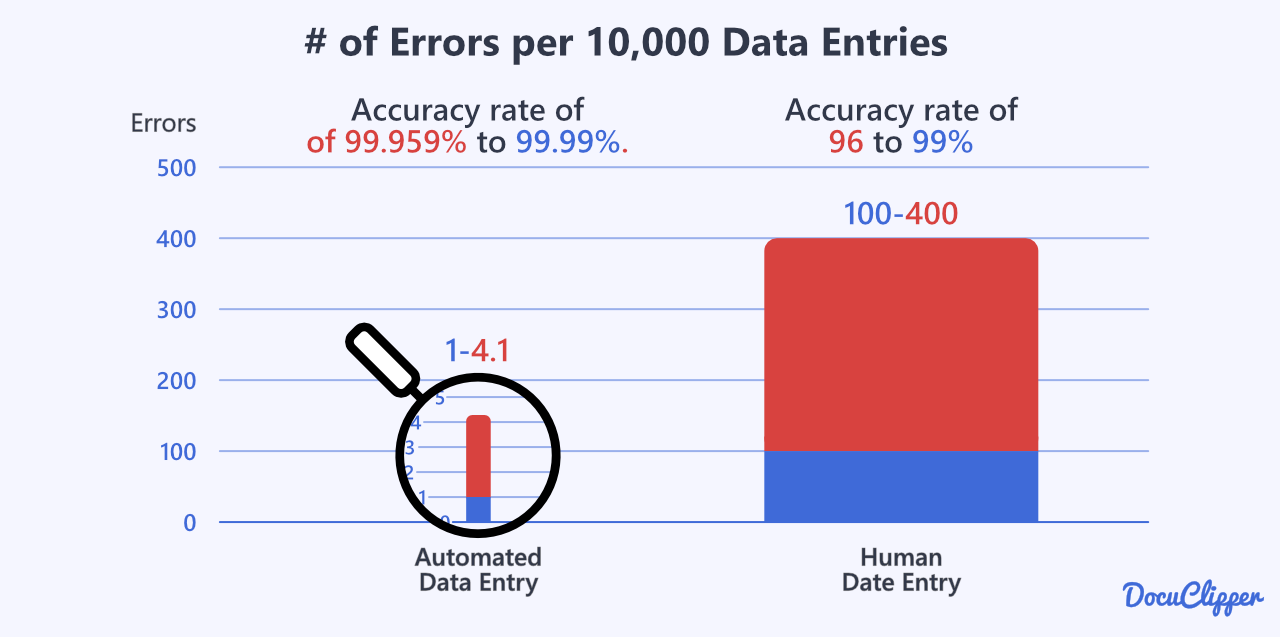
- On average, the accepted error rate in manual data entry is about 1%.
- In medical settings, date entry errors range between 0.04% and 0.67%.
Data Entry Income Statistics
- The top 10% of data entry keyers make $ 24.76 per hour and $ 51,510 annually.
- The lowest 10% earners make an hourly wage of $12.91 and $ 26,850 annually.
- The median income of data entry keyers is $ 17.40 per hour and $ 36,190 annually.
- Data Entry Keyers’ wages vary based on experience and skill level. As of the latest data, the lowest earners make an hourly wage of $12.91, while the top earners receive $24.76 per hour. The median wage stands at $17.40 per hour, which translates to an annual salary of $36,190. Overall, the annual salary range spans from $26,850 for the lowest earners to $51,510 for the top earners.
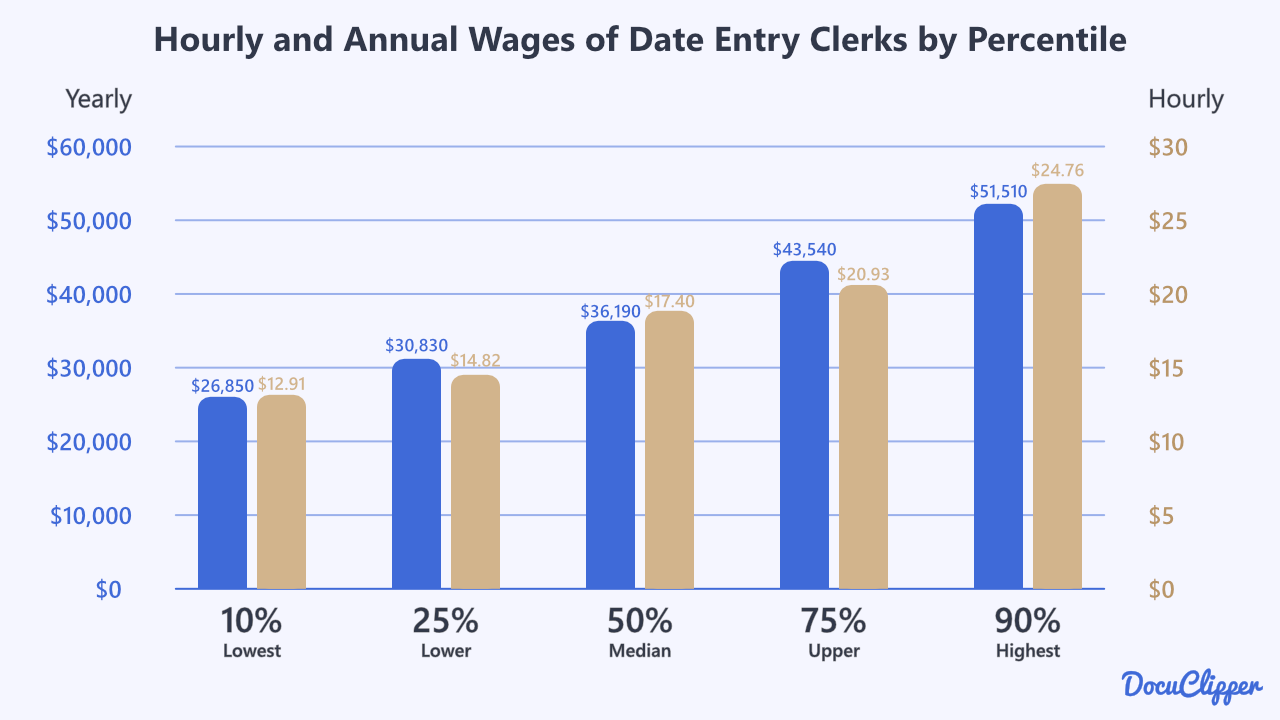
Data Entry Employment Statistics
- There are over 139,306 data entry clerks currently employed in the United States.
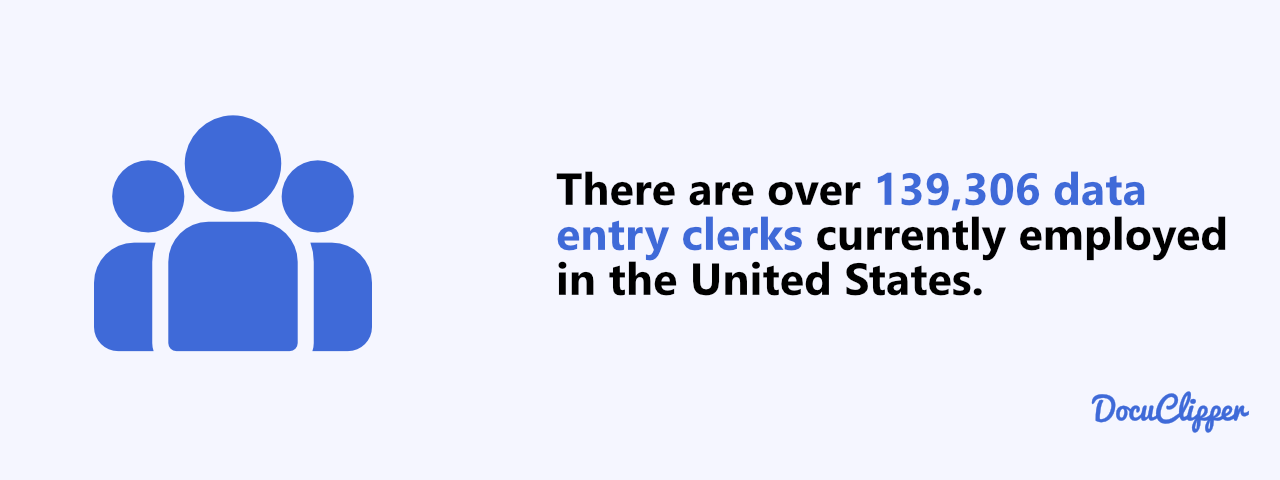
Data Entry Across Industries Statistics
- The largest industry for data entry keyers in the United States was employment services, employing over 22,000 individuals. They earned an average of $17.66 per hour, amounting to $36,720 annually.
- The second largest industry was computing infrastructure providers, data processing, web hosting, and related services. In this industry, data entry keyers make up a workforce of approximately 9,200, earning an average of $15.89 per hour, which translates to $33,040 annually.
- The third largest industry was accounting, tax preparation, bookkeeping, and payroll services, employing around 7,520 data entry keyers. These professionals earned an average of $18.02 per hour, which equates to $37,490 annually.
- In fourth place were elementary and secondary schools, with a data entry keyer workforce of approximately 6,490. They earned an average hourly wage of $17.58, translating to an annual salary of $36,560.
- The fifth-largest industry was management, scientific, and technical consulting services, employing about 6,070 data entry keyers. Their average hourly wage stood at $17.54, amounting to an annual income of $36,490.
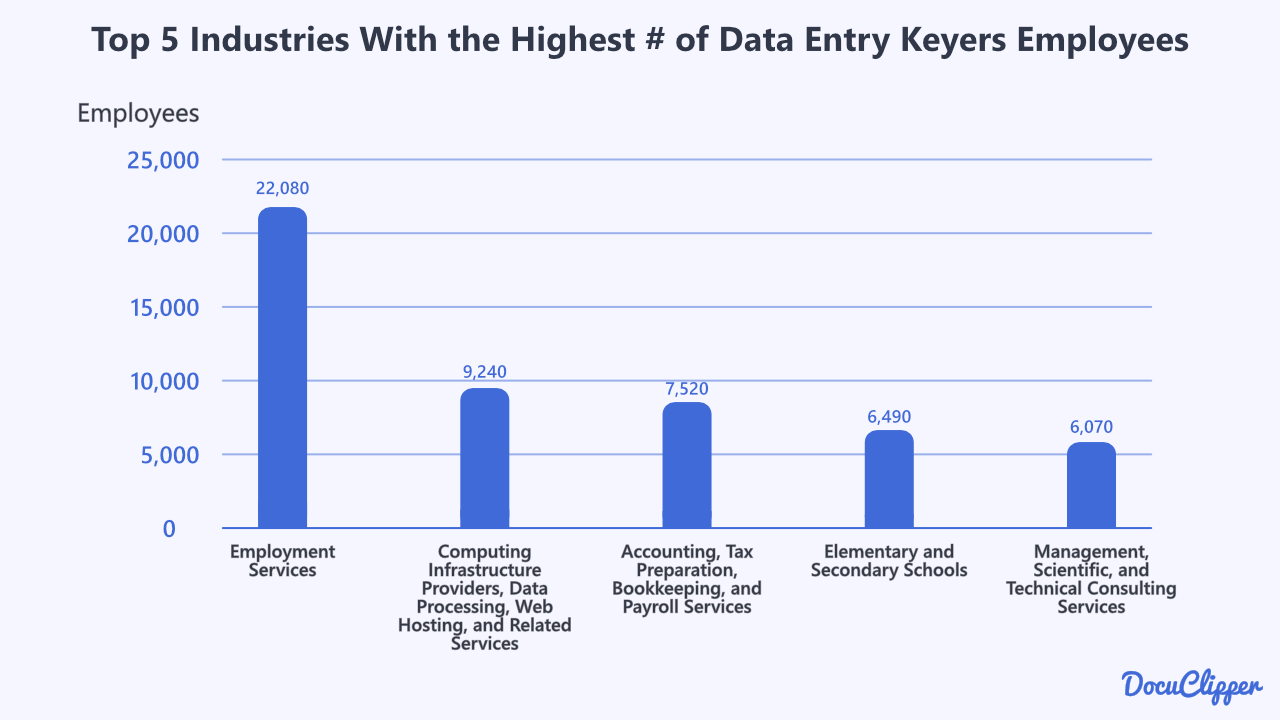
- The highest-paying industry for data entry keyers was the Postal Service (federal government), employing around 800 individuals. They earned a notable average of $26.19 per hour, which translates to an impressive $54,470 annually.
- Coming in second was the commercial and service industry machinery manufacturing sector, with about 80 data entry keyers. They received an average hourly wage of $26.02, amounting to $54,130 annually.
- The iron and steel mills and ferroalloy manufacturing industry stood third, employing approximately 40 data entry keyers. These professionals earned an average of $25.74 per hour, equating to $53,540 annually.
- In fourth place were technical and trade schools, with a workforce of around 90 data entry keyers. They earned an average of $25.72 per hour, which translates to an annual salary of $53,500.
- Rounding out the top five was the motor vehicle manufacturing industry, employing about 40 data entry keyers. Their average hourly wage was $24.85, leading to an annual income of $51,690.
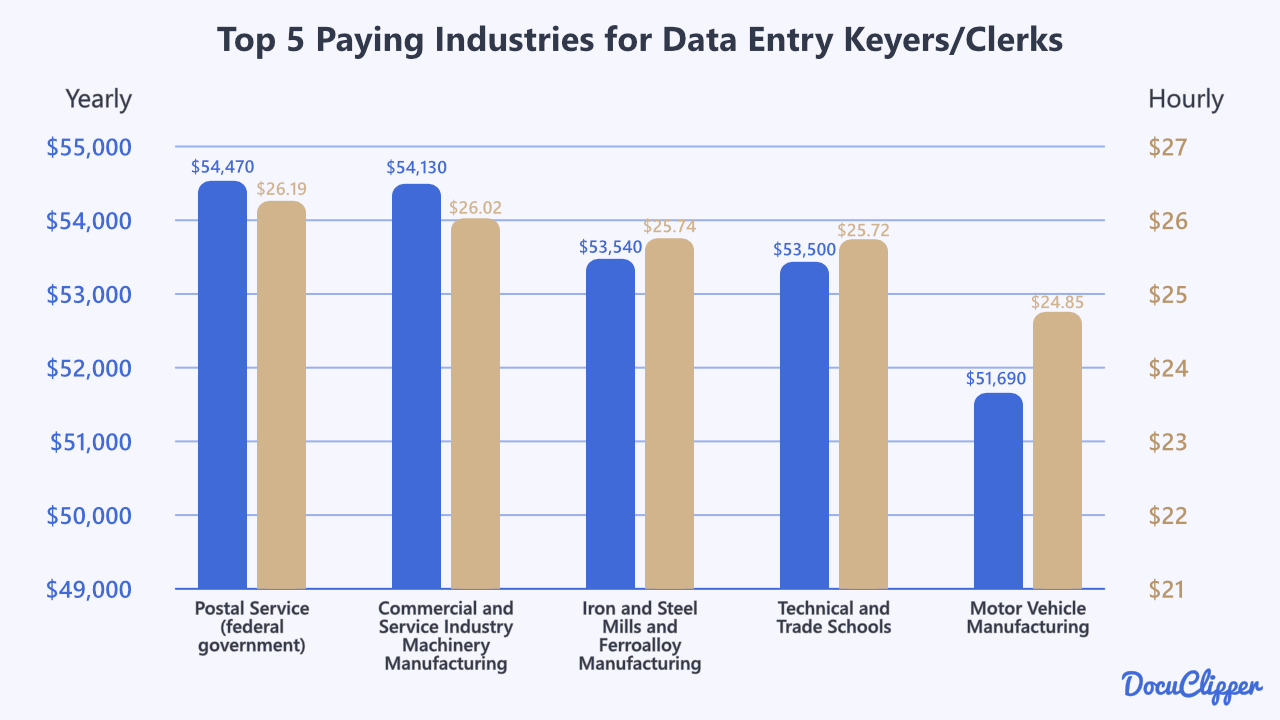
Data Entry Demographic Statistics
- Texas tops the list with the highest employment for data entry keyers, boasting 19,060 individuals in this role. They earn an average hourly wage of $17.11, which translates to an annual salary of $35,580.
- California follows in second place, employing 15,710 data entry keyers. These professionals earn a higher average hourly wage of $20.06, leading to an annual income of $41,730.
- Florida stands third with 12,410 data entry keyers. They earn an average of $17.16 per hour, amounting to $35,700 annually.
- Illinois is fourth on the list, employing 9,550 data entry keyers. They earn an average hourly wage of $18.82, which equates to an annual salary of $39,150.
- New York rounds out the top five, with 9,160 data entry keyers. They earn a notable average of $21.94 per hour, leading to an impressive annual income of $45,640.
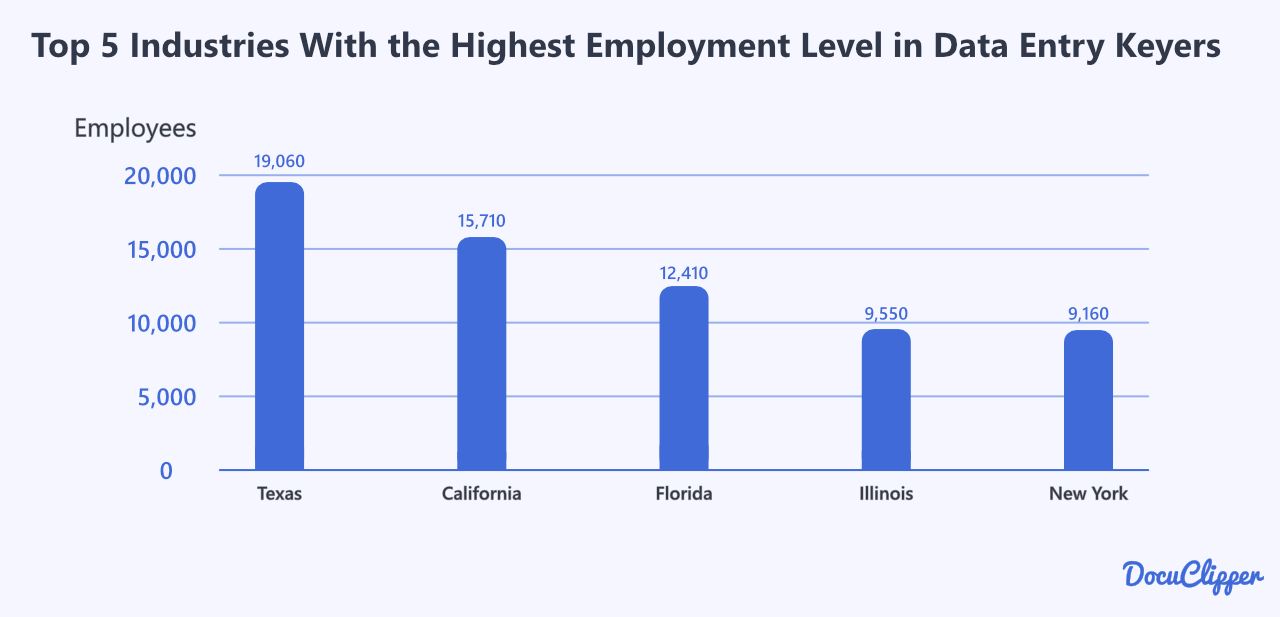
- District of Columbia leads as the highest-paying state for data entry keyers. With 360 individuals in this role, they earn a significant average hourly wage of $24.90, which translates to an annual salary of $51,790.
- Massachusetts comes in second, though specific employment data is not provided (denoted as (8)). Data entry keyers in this state earn an average hourly wage of $22.33, leading to an annual income of $46,450.
- New York is third on the list, employing 9,160 data entry keyers. They earn an average of $21.94 per hour, amounting to $45,640 annually.
- Nevada stands fourth, with 930 data entry keyers. They earn an average hourly wage of $21.26, which equates to an annual salary of $44,220.
- Colorado rounds out the top five, employing 2,070 data entry keyers. They earn an average of $20.94 per hour, leading to an annual income of $43,540.
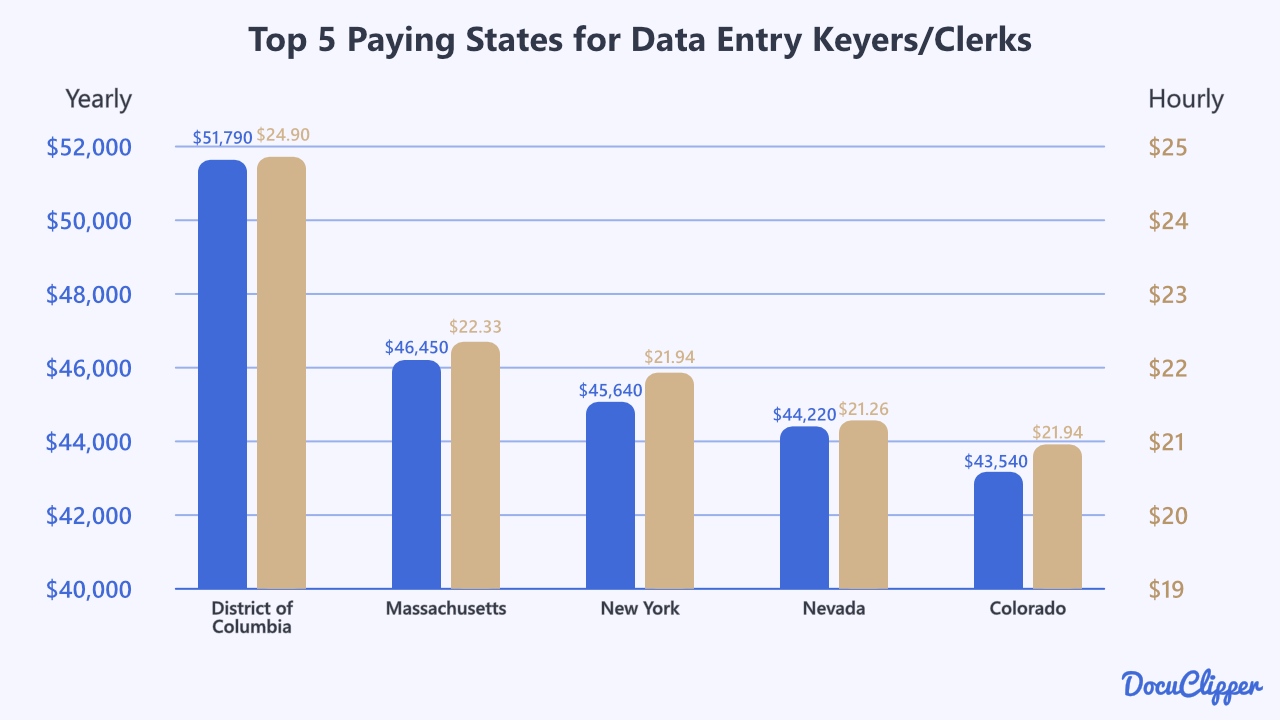
Data Entry Gender Statistics
- 80.1% of all data entry clerks are women, while 19.9% are men.
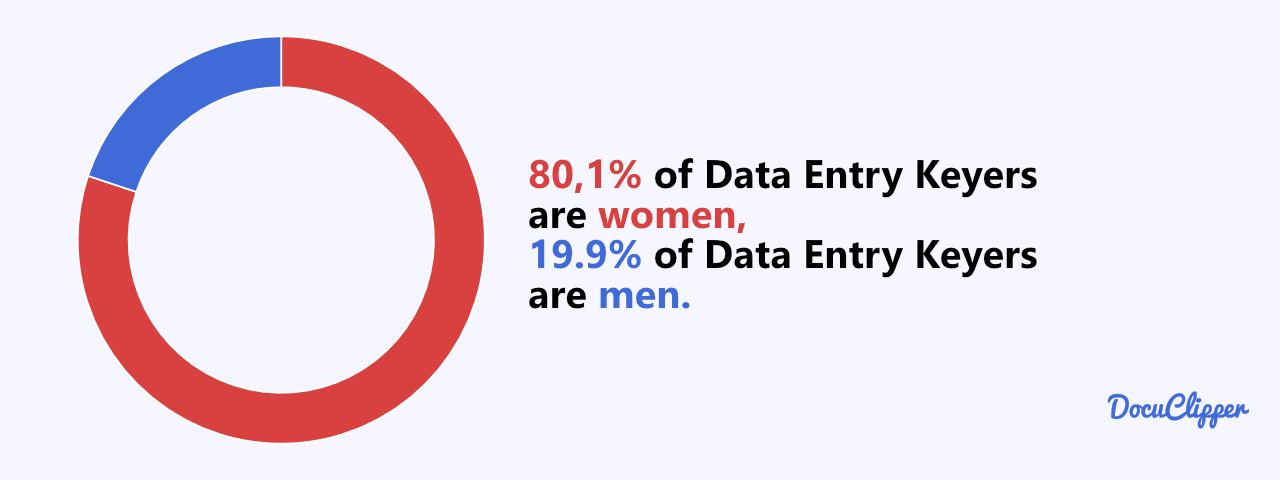
- Women data entry clerks earned 99% of what men earned.
- Over the last decade, male participation in the data entry profession has seen a steady rise, growing from 14.41% to 19.88%.
- The data suggests a trend towards greater gender diversification in the data entry profession, though it remains to be seen if this trend will continue in the coming years.
Data Entry Race Statistics
- The most common ethnicity of data entry clerks is White (54.4%), followed by Hispanic or Latino (22.8%), Black or African American (10.5%) and Asian (7.5%).
- The racial composition of data entry clerks has evolved over the past decade, with a decline in White professionals from 61.58% in 2010 to 54.38%.
- The Hispanic or Latino community has seen a consistent increase in representation in the data entry field, growing from 18.18% in 2010 to 22.84%.
- Other racial groups, such as Black or African American and Asian, have seen fluctuations over the years, but their representation remains significant, indicating a diverse workforce in the data entry profession.
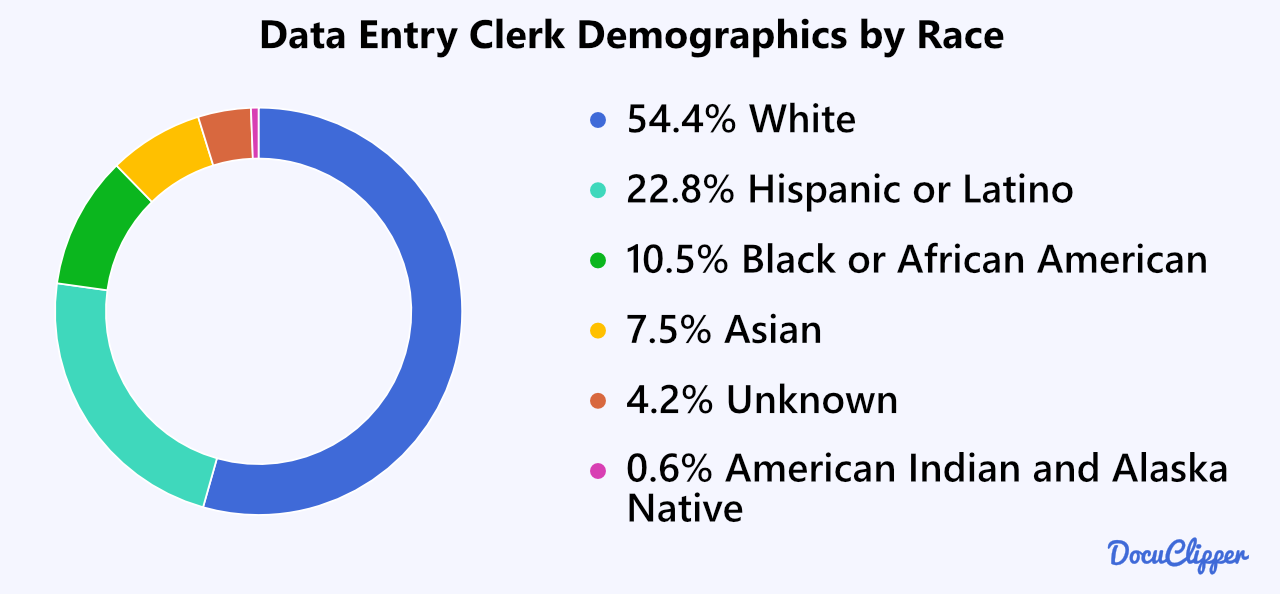
- The wage disparity among racial groups in the data entry profession is minimal, with all groups earning around the $31,500 to $32,000 range annually.
- Black or African American data entry clerks earn the most with average annual wage of $31,991.
- Asian data entry clerks earn an average of $31,584 annually, while White and Hispanic or Latino clerks earn $31,771 and $31,711, respectively.
- The close wage figures across racial groups suggest a level of wage equity in the data entry profession, though it’s essential to consider other factors like experience, location, and education when analyzing these numbers.
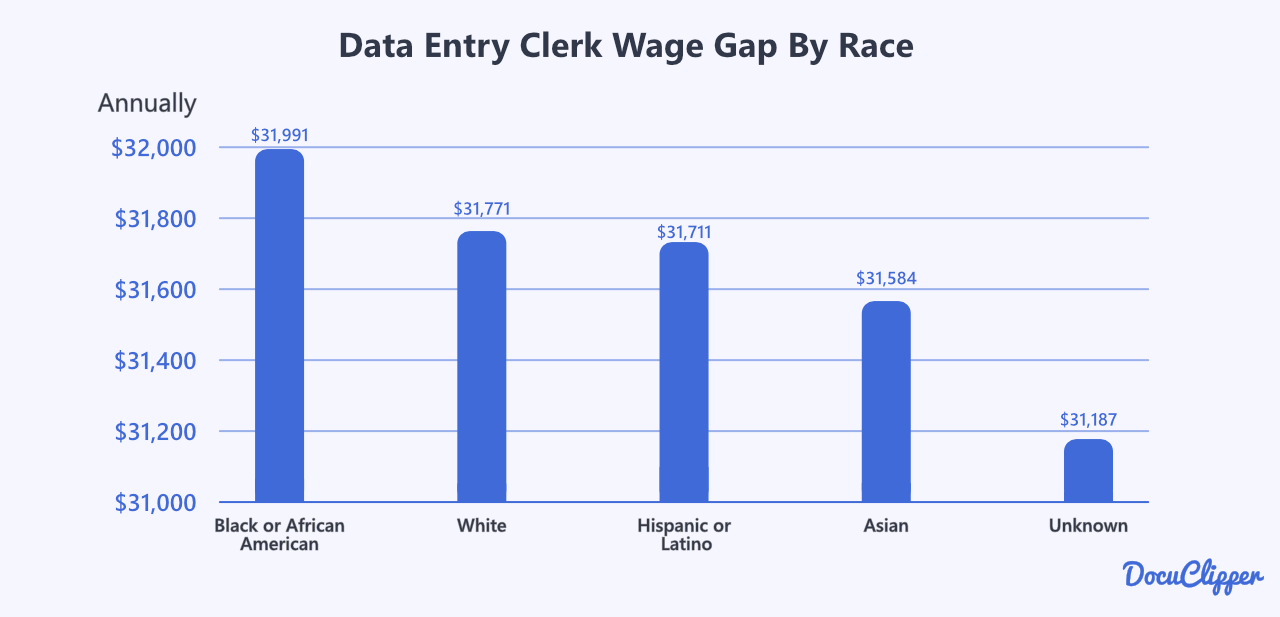
Data Entry Age Statistics
- The average data entry clerk age is 44 years old.
- An average male data entry clerk in the US is 32 years old.
- An average female data entry clerk in the US is 43 years old.
- 57% of data entry clerks in the US are over 40 years old.
- Only 20% of data entry clerks in the US are between 20-30 years old.
Data Entry Education Statistics
- Approximately 38% of all data entry in the US have a bachelor’s degree.
- 21% of all data entry clerks in the US have only finished high school.
- On average, data entry clerks with a master’s degree earn approximately $33,993 per year.
- On average, data entry clerks with a bachelor’s degree earn roughly $31,119 per year.
Related Information
Looking for more statistics? Check out these resources:
- Accounting and Bookkeeping Statistics 2025
- Credit Card Debt Statistics 2025
- Accounts Payable Statistics 2025
- 7 Human Error Statistics 2025
- Accounts Receivable Statistics 2025
Or use these resources to learn more about data entry processes:



